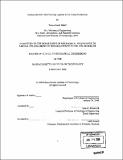| dc.contributor.advisor | John G. Brisson, II. | en_US |
| dc.contributor.author | Peters, Teresa Baker, 1981- | en_US |
| dc.contributor.other | Massachusetts Institute of Technology. Dept. of Mechanical Engineering. | en_US |
| dc.date.accessioned | 2007-01-10T16:58:37Z | |
| dc.date.available | 2007-01-10T16:58:37Z | |
| dc.date.copyright | 2006 | en_US |
| dc.date.issued | 2006 | en_US |
| dc.identifier.uri | http://hdl.handle.net/1721.1/35663 | |
| dc.description | Includes bibliographical references (p. 62-64). | en_US |
| dc.description | Thesis (S.M.)--Massachusetts Institute of Technology, Dept. of Mechanical Engineering, 2006. | en_US |
| dc.description.abstract | (cont.) Carbon dioxide is recompressed from 1.97 x 106 Pa (285 psi) to 3.96 x 106 Pa (575 psi). The process is scaled by increasing the number of nozzles to accommodate the desired flow rate. Only 165 nozzles are required to flash freeze the ice cream mix at a 2000 L/hr ice cream production rate. The power consumption of a continuous cycle implementation is modeled including single or double stage carbon dioxide recovery and compression, pre-cooling of the carbon dioxide by a standard condensing unit, pumping of the ice cream mix at high pressure and extrusion of the ice cream powder by a piston or screw extruder. The power consumption of an implementation recovering 95% of the carbon dioxide is approximately 37.3% of the power consumption of a conventional process. The cost of the make-up carbon dioxide is $0.002 per liter of ice cream. A cart implementation is also possible. | en_US |
| dc.description.abstract | Ice cream mix and other liquids are frozen by direct contact with carbon dioxide while carbon dioxide is throttled from a liquid phase to a saturated vapor phase. The process is demonstrated with a proof-of-principle apparatus that freezes discrete batches of mix. The fluid consumption, power consumption and space requirement of a continuous cycle implementation are modeled. In the proof-of-principle apparatus and the continuous cycle model, the ice cream mix is sprayed into the liquid carbon dioxide using 1.0 GPH Delavan fuel nozzles; the combined fluid is throttled by 2.0 GPH Delavan fuel nozzles, forming a fine mist during flash-freezing. The pressure at the outlet of the throttle determines the temperature of the saturated carbon dioxide vapor after the flashing process. The resulting product is a frozen carbonated ice cream powder. Depending on the implementation, 50-99% of the carbon dioxide flow is vented and can be compressed and recycled with additional make-up carbon dioxide flow. The required ratio of carbon dioxide to ice cream mix is found by balancing the change in enthalpy of each liquid from the inlet to the outlet state. For ice cream mix frozen from 5°C to -200C, the ratio is shown to be about 1.1. | en_US |
| dc.description.statementofresponsibility | by Teresa Susan Baker. | en_US |
| dc.format.extent | 66 p. | en_US |
| dc.format.extent | 4761111 bytes | |
| dc.format.extent | 4758429 bytes | |
| dc.format.mimetype | application/pdf | |
| dc.format.mimetype | application/pdf | |
| dc.language.iso | eng | en_US |
| dc.publisher | Massachusetts Institute of Technology | en_US |
| dc.rights | M.I.T. theses are protected by copyright. They may be viewed from this source for any purpose, but reproduction or distribution in any format is prohibited without written permission. See provided URL for inquiries about permission. | en_US |
| dc.rights.uri | http://dspace.mit.edu/handle/1721.1/7582 | |
| dc.subject | Mechanical Engineering. | en_US |
| dc.title | Carbon dioxide flash-freezing applied to ice cream production | en_US |
| dc.type | Thesis | en_US |
| dc.description.degree | S.M. | en_US |
| dc.contributor.department | Massachusetts Institute of Technology. Department of Mechanical Engineering | |
| dc.identifier.oclc | 76767500 | en_US |
